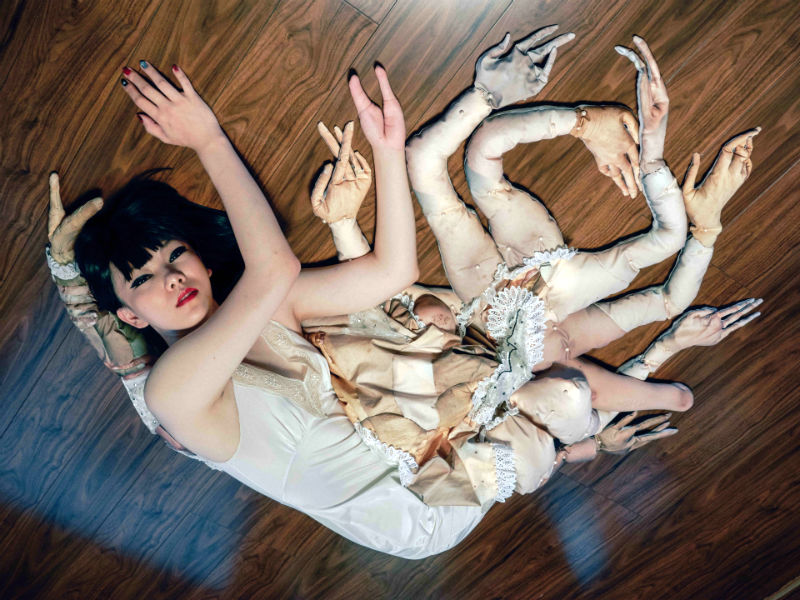The Body Politic: Japanese artist Mari Katayama challenges attitudes toward the differently abled in her debut U.S. solo show

The first solo show in the United States for Japanese artist Mari Katayama is right here in Ann Arbor.
Katayama’s works are on display at the University of Michigan Museum of Art in the Irving Stenn Jr. Family Gallery through January 26, 2020. Her creations include both photographs and sculptures that disrupt normative viewing of the body, which weave a narrative that rejects dominant cultural and societal attitudes toward disabled bodies. Katayama not only uses her own body as a subject, but she also incorporates surrealist, complex, and skillful handmade prosthetics from textiles and other materials. Her works explore concepts of the self, the body and objectification, voyeurism, and agency.
In the gallery wall text, UMMA curator Natsu Oyobe gives an overview of Katayama’s approach, background, and inspiration. Oyobe states Katayama’s work is “intimate, as she unflinchingly displays her disabled body,” noting the artist was “born in 1987 with a rare developmental condition, she had her legs amputated at the age of 9, and has only two fingers on one hand. Katayama began her art practice as a personal search for identity, after recognizing a deep gap between her own understanding of her physical condition and contemporary society’s simplistic categories of people with disabilities.”
Katayama’s art takes up the hard work of shattering cultural expectations and perceptions by using her own body and experiences as starting points from which to explore several themes.
From both outside and inside the gallery, a two-part photographic installation can be seen. The large panels consume four of the exterior windows, with macro, cropped-in images of Katayama’s limbs. Each panel contains a swath of flesh and bone that ranges from abstract to figurative, but each differs from the next. Inside, the panels create one continuous image of Katayama’s legs against a teal backdrop, that during the day changes the lighting of the space by casting a blue-green hue to the well-lit room. In front of the photographic window panels, a large sculptural installation made from textiles, rope, hair, pillows, shells, and found objects fill the front of the gallery space. This installation is also incorporated into the fine detail of the gallery setup, covering the generally muted-gray stanchions with embellished twine.
The backdrop for many of Katayama’s photographs is the once-polluted Watarase River, which passes through her home city of Ōta. After visiting Flint last year, Oyobe notes that the artist sensed a connection to issues of environmental justice and water pollution in her city. Water is a prominent feature in Katayama’s work, from the inclusion of oceanic material such as shells to the series cannot turn the clock back, which feature four inanimate objects against an abstracted Watarase River and a tryptic of portraits of Katayama in various stages of turning away from the camera.
On the wall adjacent to the photographic window panels, four large C-prints illustrate Katayama’s range of talent in creating props for her works. These four images include some of Katayama’s elaborate self-made prosthetics and feature the artist posing in both dynamic accessories and environments. Through these four images, Katayama seems to ask audiences to consider automatic responses to non-normative bodies by visually exaggerating what is socially and culturally deemed as abnormal.
While Katayama uses herself as a subject in her photographic work, Oyobe points out the artist does not consider the resulting images self-portraiture. “She treats her entire body, bodily parts, and prosthetics as ‘materials’ to be arranged in photographs and soft sculptures.” The resulting photographs are narrative scenes in which “she invites the viewer to voyeuristically experience a private space developed from her imagination.”
The stylistic approach to Katayama's images results in body objectification, which Oyobe aptly suggests “exposes anxieties that haunt many of us -- disabled or nondisabled -- living in an age obsessed with body image.” Through her artistic practice, Katayama exposes this fraught obsession, asking audiences to consider the body as a site of constant manipulation and change.
These artworks are explorations of embodiment and absurdity that interrogate what it means to view and live in a body in the 21st century, particularly concerning disability and cultural expectations of normality. Katayama’s works create a realm of contemplative surrealist absurdity through sculpture, textiles, and photography.
Elizabeth Smith is an AADL staff member and is interested in art history and visual culture.
Mari Katayama’s works are on display at the University of Michigan Museum of Art in the Irving Stenn Jr. Family Gallery through January 26, 2020.


































